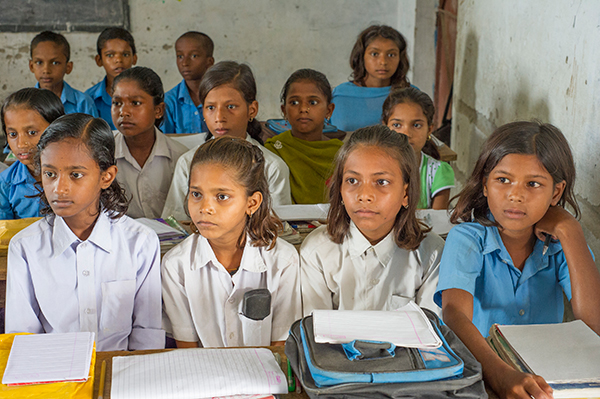
“No education, no development.” That was the clarion call of Norway’s Prime Minister Erna Solberg ahead of the Oslo Summit on Education and Development held in Norway July 6 e 7.
The Summit focused on girls’ education with the recognition that their education has not only a lasting impact on the girls themselves but on their families and communities too, and ultimately catalyzes development.
Educated girls are better equipped for work and life. They tend to marry and have children later, have fewer babies and are better equipped to invest more in their children’s health and education. Society and future generations benefit from girls’ education.
The topic of girls’ education and gender equality has become common in policy forums, a positive focus. While some may think such attention is no longer necessary because of progress made toward achieving the Millennium Development Goal of universal primary education, much work still remains.
Ao longo do passado 20 anos, we have seen an equalizing in primary school enrollment for girls and boys in most – but not all – countries.
In a background paper for the Summit, Today’s Challenges for Girls’ Education, Elizabeth King and Rebecca Winthrop report that there are still 80 countries that do not have gender parity in primary and secondary school enrollment. Em 30 countries where girls and boys are enrolled at a mostly even rate, the quality of education is low. And in 30 countries where there is both high enrollment and quality education, adolescent girls still lag behind boys in math.
Boys too suffer from the gender gap, including those who are at a disadvantage to girls with regard to reading in some countries.
Gender gaps are more common in poor countries, in remote rural areas and among disadvantaged populations. A growing percentage of out of school children also live in countries affected by conflict and other emergencies. Four of five countries with the largest gender gaps are conflict-affected.
Em outras palavras, girls’ education lags in countries that most need educated people to help them advance.
We’ve known for a while what prevents girls from getting the education they deserve. Families and communities have lower expectations of girls than boys. Muitas vezes, marriage and motherhood define parental hopes for girls rather than careers and leadership. The opposite holds true for boys, who are expected to be the breadwinners.
Girls’ education is restricted by early and child marriages and teen pregnancy. It is also economically driven. When families are only able to pay the education costs of one child, they choose to educate boys over girls. The girls are more commonly kept home to help with child-care and household work.
Some girls are kept from school out of concern for their safety and security. Girls and young women (and sometimes boys) can be targets of violence in schools, subject to bullying, sexual abuse and exploitation—all factors that undermine learning.
Parents and communities reflect existing patriarchal norms when prioritizing the education of boys over girls. But doing so contradicts research that proves the real and lasting economic benefits of educating girls.
Girls who grow up in low-income families typically end up working to help support their families with limited to no education or skills. Como resultado, these girls become women who remain trapped in low-paying and unstable work, usually in agriculture or the informal economy.
We know how to fix these problems.
Nós sabemos, por exemplo, that parents are more inclined to send their girls to school if there will be a female teacher, who in turn can also serve as an excellent role model. We also know that girls are more likely to be sent to school if the parents feel assured of their safety. Como resultado, safe transportation or adult accompaniment and school boundary walls can allay concerns, as do dedicated toilets for girls.
For nearly four decades, Creative Associates International has been committed to girls’ education.
Creative knows that girls learn better when they see themselves depicted in text book pictures and stories. Girls learn better when teachers invite them to join the boys in classroom activities. Both girls and boys can imagine themselves in more varied roles when they engage non-traditional texts and activities. When this occurs, gender norms begin to change.
The global development organization also knows that educating parents, communities and religious leaders about the importance of girls’ education is effective. They become stakeholders when they are involved in designing solutions for their own schools, whether to improve security, recruit female teachers or demand quality teaching and learning.
Seguro, high quality, gender equal school environments are good not just for girls but for all students.
The world has a unique opportunity over the next couple of months to demand improvements and greater investment in girls’ education.
On July 13, global leaders will gather in Addis Ababa, Etiópia, no Terceira Conferência Internacional sobre Financiamento para o Desenvolvimento. They will work out funding for a new set of Sustainable Development Goals (ODS) that will be finalized in September. These goals will provide a vision and guide development for the next 15 anos.
UN Secretary General Ban Ki-moon lamented that the Objectivos de Desenvolvimento do Milénio definir 15 years ago concerning women and girls have been the most neglected.
Agora é a hora do progresso real. “No education, no development.” It is time to refresh our commitment to girls’ education, set visionary targets and commit the necessary resources for a brighter future for the world’s children. Because it matters.
Rehka Mehra is a Senior Associate, Cross-Functional Group, with expertise in gender and economic development.
Chelsea Decaminada is an intern with the Cross-Functional Group.